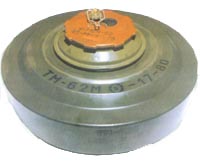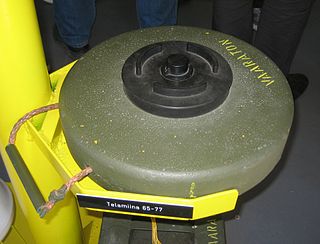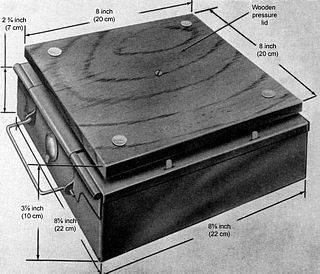The TM-44 was a circular metal-cased Soviet anti-tank landmine used during the Second World War. The mine's case consisted of a short cylinder with the entire top surface being used as a pressure plate. The mine was normally painted olive drab and was broadly similar to the earlier, smaller, TM-41 mine.

The Soviet Union, officially the Union of Soviet Socialist Republics (USSR), was a federal sovereign state in northern Eurasia that existed from 1922 to 1991. Nominally a union of multiple national Soviet republics, its government and economy were highly centralized. The country was a one-party state, governed by the Communist Party with Moscow as its capital in its largest republic, the Russian Soviet Federative Socialist Republic. Other major urban centers were Leningrad, Kiev, Minsk, Tashkent, Alma-Ata, and Novosibirsk. It spanned over 10,000 kilometers (6,200 mi) east to west across 11 time zones, and over 7,200 kilometers (4,500 mi) north to south. It had five climate zones: tundra, taiga, steppes, desert and mountains.
The TM-41 was a circular, metal-cased Soviet anti-tank landmine used during the Second World War. The mines case consisted of a short cylinder with the entire top surface being used as a pressure plate. The mine has a carrying handle on the side of the mine. It was normally painted olive drab and was broadly similar to the larger, later, TM-44 mine.
The earlier TM-41 was used widely between 1941 and 1942, but production was discontinued because of the lack of metal available to Soviet industry. [1] By 1944 the situation had improved and production of metal mines resumed. The TM-44 is similar to the earlier mine, weighing more with a larger charge.
140 to 260 kilograms of pressure on the top pressure plate resulted in it bending downwards and pressing on the MV-5 fuze. One to three kilograms of pressure on the head of the fuze was sufficient to activate it. The fuze's lock balls are forced out of position by the pressure, releasing a striker, which triggers a detonator, then a booster and then the mine's main charge. The mine was used with anti-handling devices.

An anti-handling device is an attachment to—or an integral part of—a landmine or other munition e.g. some fuze types found in general purpose air-dropped bombs, cluster bombs and sea mines. It is designed to prevent tampering. When the protected device is disturbed, it detonates, killing or injuring anyone within the blast area. There is a strong functional overlap of booby traps and anti-handling devices.
Production of the mine ceased in 1946 with the adoption of the TM-46 mine, which was modelled on German Tellermine designs.

The TM-46 mine is a large, circular, metal-cased Soviet anti-tank mine. It uses either a pressure fuze or tilt-rod, which is screwed into the top. Anti-tank mines with this type of fuze were capable of inflicting much more damage to armored vehicles. The TMN-46 is a variant of the mine fitted with a secondary fuze well on the bottom which is slightly off-set from the centre of the mine. This secondary fuze well can be fitted with a pull-fuze which functions as an anti-handling device. The mine was used by the North Vietnamese forces during the Vietnam War, and is found in many countries in Africa, the Middle East and South East Asia.
The mine was prone to rusting, exposing the MV-5 fuze which could be triggered by as little as 1 to 3 kilograms of pressure. It is found in Yemen.

Rust is an iron oxide, a usually red oxide formed by the redox reaction of iron and oxygen in the presence of water or air moisture. Several forms of rust are distinguishable both visually and by spectroscopy, and form under different circumstances. Rust consists of hydrated iron(III) oxides Fe2O3·nH2O and iron(III) oxide-hydroxide (FeO(OH), Fe(OH)3).

Yemen, officially the Republic of Yemen, is a country at the southern end of the Arabian Peninsula in Western Asia. It is the second-largest Arab sovereign state in the peninsula, occupying 527,970 square kilometres. The coastline stretches for about 2,000 kilometres. It is bordered by Saudi Arabia to the north, the Red Sea to the west, the Gulf of Aden and Guardafui Channel to the south, and the Arabian Sea and Oman to the east. Yemen's territory encompasses more than 200 islands, including Socotra, one of the largest islands in the Middle East. Yemen is a member of the Arab League, United Nations, Non-Aligned Movement and the Organisation of Islamic Cooperation.













